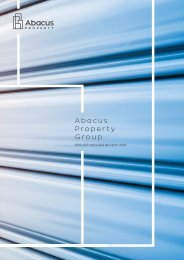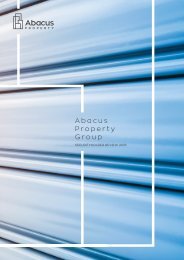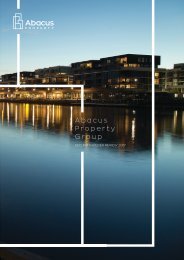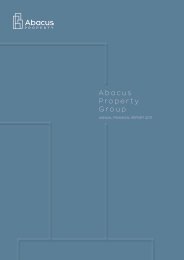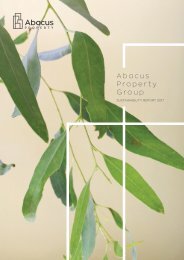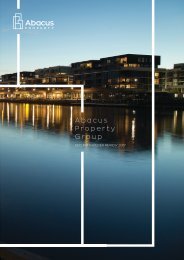Abacus Property Group – Annual Financial Report 2018
You also want an ePaper? Increase the reach of your titles
YUMPU automatically turns print PDFs into web optimized ePapers that Google loves.
ABACUS PROPERTY GROUP<br />
NOTES TO THE FINANCIAL STATEMENTS<br />
30 JUNE <strong>2018</strong><br />
12. FINANCIAL INSTRUMENTS (continued)<br />
(d) Fair values<br />
The fair value of the <strong>Group</strong>’s financial assets and liabilities are approximately equal to that of their carrying<br />
values.<br />
Class of assets /<br />
liabilities<br />
Fair value<br />
hierarchy Valuation technique Inputs used to measure fair value<br />
Investment properties Level 3 Discounted Cash Flow ("DCF") and<br />
Income capitalisation method<br />
Adopted capitalisation rate<br />
Optimal occupancy<br />
Adopted discount rate<br />
<strong>Property</strong>, plant and<br />
equipment<br />
Level 3 Income capitalisation method Net market EBITDA<br />
Optimal occupancy<br />
Adopted capitalisation rate<br />
Derivative - project<br />
entitlement<br />
Level 3 Residual cash flow analysis Project cash flow forecast<br />
Project payment priorities<br />
Securities and options<br />
- unlisted<br />
Level 3 Pricing models Security price<br />
Underlying net asset<br />
<strong>Property</strong> valuations<br />
Derivative - financial<br />
instruments<br />
Level 2<br />
DCF (adjusted for counterparty credit<br />
worthiness)<br />
Interest rates<br />
Consumer Price Index ("CPI")<br />
Volatility<br />
Level 1<br />
Level 2<br />
Level 3<br />
Quoted prices (unadjusted) in active market for identical assets or liabilities;<br />
Inputs other than quoted prices included in level 1 that are observable for the asset or liability, either<br />
directly (i.e. as prices) or indirectly (i.e. derived from prices); and<br />
Inputs for the asset or liability that are not based on observable market data.<br />
There were no transfers between Levels 1, 2 and 3 during the period.<br />
Income capitalisation method<br />
Discounted cash flow method<br />
Residual cash flow analysis<br />
Pricing models <strong>–</strong> unlisted<br />
securities<br />
Pricing models <strong>–</strong> options<br />
This method involves assessing the total net market income receivable from the property and<br />
capitalising this in perpetuity to derive a capital value, with allowances for capital expenditure<br />
reversions.<br />
Under the DCF method, the fair value is estimated using explicit assumptions regarding the benefits<br />
and liabilities of ownership over the assets’ or liabilities’ life including an exit or terminal value. The<br />
DCF method involves the projection of a series of cash flows from the assets or liabilities. To this<br />
projected cash flow series, an appropriate, market-derived discount rate is applied to establish the<br />
present value of the cash flow stream associated with the assets or liabilities.<br />
The analysis takes into account the time value of money in a more detailed way than simply a<br />
developer’s profit margin as it considers the timing of all costs and income associated with the project.<br />
The fair value is determined by reference to the net assets which approximates fair value of the<br />
underlying entities.<br />
The fair value is determined using generally accepted pricing models including Black-Scholes and<br />
adjusted for specific features of the options including share price, underlying net assets and property<br />
valuations and prevailing exchange rates.<br />
66



